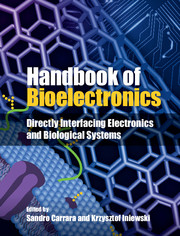Book contents
- Frontmatter
- Contents
- List of Contributors
- 1 What is bioelectronics?
- Part I Electronic components
- 2 Molecular components for electronics
- 3 Nanogaps and biomolecules
- 4 Organic thin-film transistors for biological applications
- 5 Protein-based transistors
- 6 Single-molecule bioelectronics
- 7 Nanoscale biomemory device composed of recombinant protein variants
- Part II Biosensors
- Part III Fuel cells
- Part IV Biomimetic systems
- Part V Bionics
- Part VI Brain interfaces
- Part VII Lab-on-a-chip
- Part VIII Future perspectives
- Index
- References
5 - Protein-based transistors
from Part I - Electronic components
Published online by Cambridge University Press: 05 September 2015
- Frontmatter
- Contents
- List of Contributors
- 1 What is bioelectronics?
- Part I Electronic components
- 2 Molecular components for electronics
- 3 Nanogaps and biomolecules
- 4 Organic thin-film transistors for biological applications
- 5 Protein-based transistors
- 6 Single-molecule bioelectronics
- 7 Nanoscale biomemory device composed of recombinant protein variants
- Part II Biosensors
- Part III Fuel cells
- Part IV Biomimetic systems
- Part V Bionics
- Part VI Brain interfaces
- Part VII Lab-on-a-chip
- Part VIII Future perspectives
- Index
- References
Summary
Introduction: A survey of proteins in nanobioelectronics
The idea of using proteins to assemble hybrid electronic devices stems from molecular electronics [1] and, as such, it is intimately connected with the advent of nanosciences and nanotechnologies, dating back to the early 1990s. Since then, much technological effort but less scientific effort has been deployed to try to implement devices that take advantage of the peculiar features of proteins.
A technologist’s standpoint is that of regarding proteins as self-contained, nanometer-sized functional units, highly specialized and efficient in performing a certain functional task. Their efficiency is traced back to the fact that, being active parts of living beings, proteins are taking advantage of billions of years of natural evolution in specializing towards a given activity.
This way of thinking, which one can often encounter in ritten or spoken accounts, appears to be questionable in light of a rather less naïve understanding of the theory of evolution, but is perhaps a good enough starting point to understand the historical motivations which led to the remarkable interest of a interdisciplinary part of the scientific community in the use of proteins for assembling electronic devices.
The other aspect motivating the interest in proteins as elements in electronic circuits is their size.
- Type
- Chapter
- Information
- Handbook of BioelectronicsDirectly Interfacing Electronics and Biological Systems, pp. 49 - 65Publisher: Cambridge University PressPrint publication year: 2015



